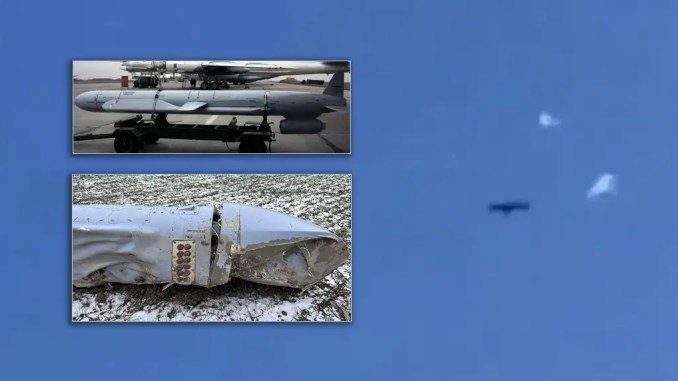
The video reportedly shows the Kh-101 air-launched cruise missile that appears to have been equipped earlier this year with countermeasure systems.
A video, allegedly recorded during the latest round of Russian attacks on Ukraine, appears to show a Kh-101 air-launched cruise missile releasing flares to deceive Ukrainian air defenses. The weapon is known to have been equipped with radio frequency countermeasures, commonly known as chaffs, since the beginning of 2023. This upgrade was discovered from the analysis of photos of Kh-101s’ wreckages, which showed the countermeasures dispensers.
This video, if confirmed authentic, could be the first time the Kh-101 was caught on camera while employing the countermeasures. It is not known how the countermeasures are controlled, as it has been assumed they are linked to a radar warning receiver or some similar sensor, but there is no photographic evidence. Another option would be a simple pre-programmed ejection of chaff/flares at timed intervals or waypoints.
Kh-101s began receiving radio frequency countermeasures (RFCMs, “chaff”) dispensers at the beginning of this 2023. It has been implied/assumed that these they are integrated with a radar warning receiver (RWR) suite, but I have not seen images of the RWR suite and sensors itself. pic.twitter.com/jFWrxWsKN8
— John Ridge 🇺🇸 🇺🇦 (@John_A_Ridge) December 29, 2023
The Kh-101 is a fairly recently developed long range cruise missile roughly analogous to the U.S. Tomahawk family of cruise missiles, which was already employed in Syria during Russian Tu-95 and Tu-160 bomber strikes in 2016 and 2017. Eight Kh-101 cruise missiles can be carried by a Tu-95 bomber, while twelve can be carried by a Tu-160.
The Kh-101 cruise missile has an effective combat range of 2,790-3,000 miles (about 4,500+ kilometers) and can carry a variety of different warheads depending on the target to be struck. The missile is reported to have low-observable (“stealth”) characteristics and is capable of adjusting its targeting while in flight to the assigned target. The Kh-101 missile is, in fact, believed to use a combination of inertial guidance and satellite navigation using the Russian GLONASS system, with opto-electronic flight correction system. Its accuracy is reported as “within 10 meters”.
- SEO Powered Content & PR Distribution. Get Amplified Today.
- PlatoData.Network Vertical Generative Ai. Empower Yourself. Access Here.
- PlatoAiStream. Web3 Intelligence. Knowledge Amplified. Access Here.
- PlatoESG. Carbon, CleanTech, Energy, Environment, Solar, Waste Management. Access Here.
- PlatoHealth. Biotech and Clinical Trials Intelligence. Access Here.
- Source: https://theaviationist.com/2023/12/29/russian-cruise-missile-flares/?utm_source=rss&utm_medium=rss&utm_campaign=russian-cruise-missile-flares




